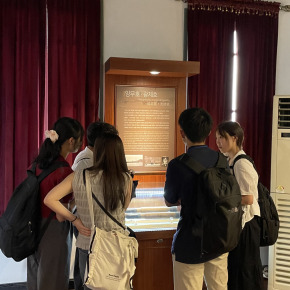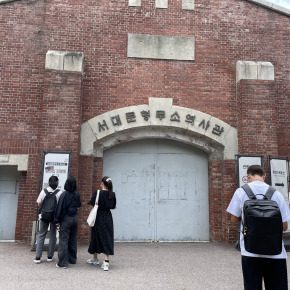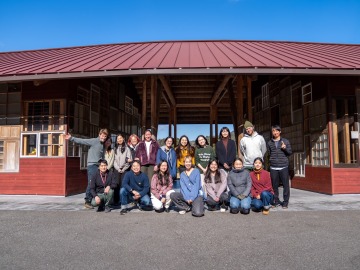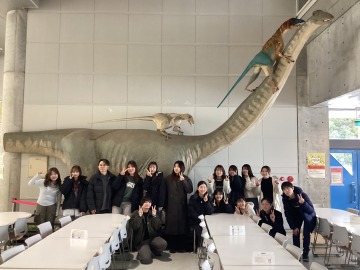Overview of Activities
Destination: Korea Seoul, Incheon
Participants: 10 students
Period: August 26, 2025 (Tuesday) to August 29, 2025 (Friday)
Activity Report
1) Theme
Approaches to Korea’s “Historical Memory”
2) Concept and Goals
・Learn how to take over “historical memory” in Korea to the next generation through on-site experiences.
・Experience learning through “dark tourism” (visiting sites associated with tragedy, such as battlefields or disaster zones)
・Gain insight into Japan and ourselves by learning about Korea’s history (fostering mutual understanding)
・Utilize the experience as an opportunity for continuous reflection and contemplation while standing on the “boundary line” between Japan and Korea
Five students from the Department of Japanese Studies, Hanyang University ERICA also participated in the training, enjoyning exchanges.
Experience Report from a participant
Participating in this program provided the perfect firsthand experiences, leading to memorable lessons about how Korea addresses “historical memories.” It is crucial to understand that an indirect approach gained through texts and images can only offer limited insights into historical stories. By travelling on-site to historic sites, by witnessing exhibitions, and listening to personal stories, history came into being not as textbook knowledge but as a “living memory.” Never before has “feeling history” so intensely left its impact during these four days.
Firstly, the experience highlighted the importance of staying mindful of local characteristics and the historical background when approaching exhibitions to perceive the intended meanings incorporated in the displays. Museums and memorials are often thoughtfully constructed by those who plan them, rather than being simply collections of historical facts. Questions like “how should memory be communicated?” and “what aspects need to be highlighted?” irretrievably influence these spaces. People thus need to examine both the historical context and the contemporary social framework surrounding the information they receive. Some exhibitions, for instance, aimed to reconstruct reality with uncompromising accuracy, while others used animation and other media to show cross-national and cross-ethnic knowledge. Nowadays, as the generation with immediate war experience fades, sophisticated audiovisual technology and even virtual impacts, such as vibrating floors, allow visitors to experience quasi-experiences of the past. The diversity in these expressions was striking, but what stood out most was the intense “will to communicate” that each expressed.
In addition, studying history is not just about absorbing knowledge of the past; it also serves as a catalyst to challenge stereotypes. Even though it is nearly impossible, history should never align with any specific point of view. Unfortunately, individuals often unconsciously perceive the world through frames shaped by their education and the conventions of their nation, demonstrating the complexity of proper historical studies. Thus, it is important to question one’s own assumptions, taking a step back and looking from an external viewpoint. Further, this program has proven that the Japanese educational system is limited in its accessibility to knowledge regarding the history of Japan’s annexation of Korea, territorial disputes, and issues of “comfort women” that are highly related to Japanese society. Textbooks and literature are written by individuals whose patriotism or national loyalty may lead to the minimization of inconvenient facts. Therefore, only through the study of diverse perspectives can the essence of history be understood. Moreover, it was especially poignant to recognize that Japan often tends to overlook its problematic histories by rationalizing them as “things of the past” during this trip. On the one hand, in some places, like Japan, problematic histories like war and colonialism tend to seem remote, allowing for the rationalization that they have nothing to do with the present. On the other hand, yet, there are still places like Korea where historical tragedies linger unresolved and amidst everyday life. Specifically, the Korean War still hasn’t fully ended, and issues like the comfort women and border conflicts linger unresolved. Observing this reality served to emphasize that past and present are inseparable.
“This is our past, but it is also your present,” is one of the most memorable messages conveyed by the exhibitions. Documenting histories of victimhood is not just mourning but a lesson that cautions against repeated errors in the future. It is important to remember caution and accept it as personal responsibility. Also, examining history from multiple perspectives and visiting historical sites can help people better fit together their complex historical puzzle. Thus, in other words, understanding the past not only as a historian from a textbook but as someone involved is the responsibility of our generation. This experience made clear that “learning history” and “facing history” are not the same. Learning history means expanding knowledge, while facing history means repeatedly examining it by oneself and taking responsibility in the face of that knowledge. Many problems remain unsettled between Korea and Japan, but reconciliation needs more than transferring responsibility to governments or professionals. It needs everyday people to share historical memory and participate in prolonged dialogue.
Lastly, the program offered a new viewpoint: that “historical memory” need not be thought of as a leftover of the past but a resource for generating the future. History is usually complex and sometimes hurtful, but approaching it allows for the stripping away of preconceptions and the diversifying and deepening of vision. The insights from Korea will offer a fresh perspective on Japan’s history and serve as a starting point for future reflection. This SI program thereby offered an invaluable and irreplaceable experience—an experience that has the potential to transform historical memory from a residual of the past into a foundation for reflection, conversation, and the goal of a more just future. Hence, participation in WISH Study Tour offers opportunities for unique experiences available only within WISH.
(Sakiho MIYAI)














